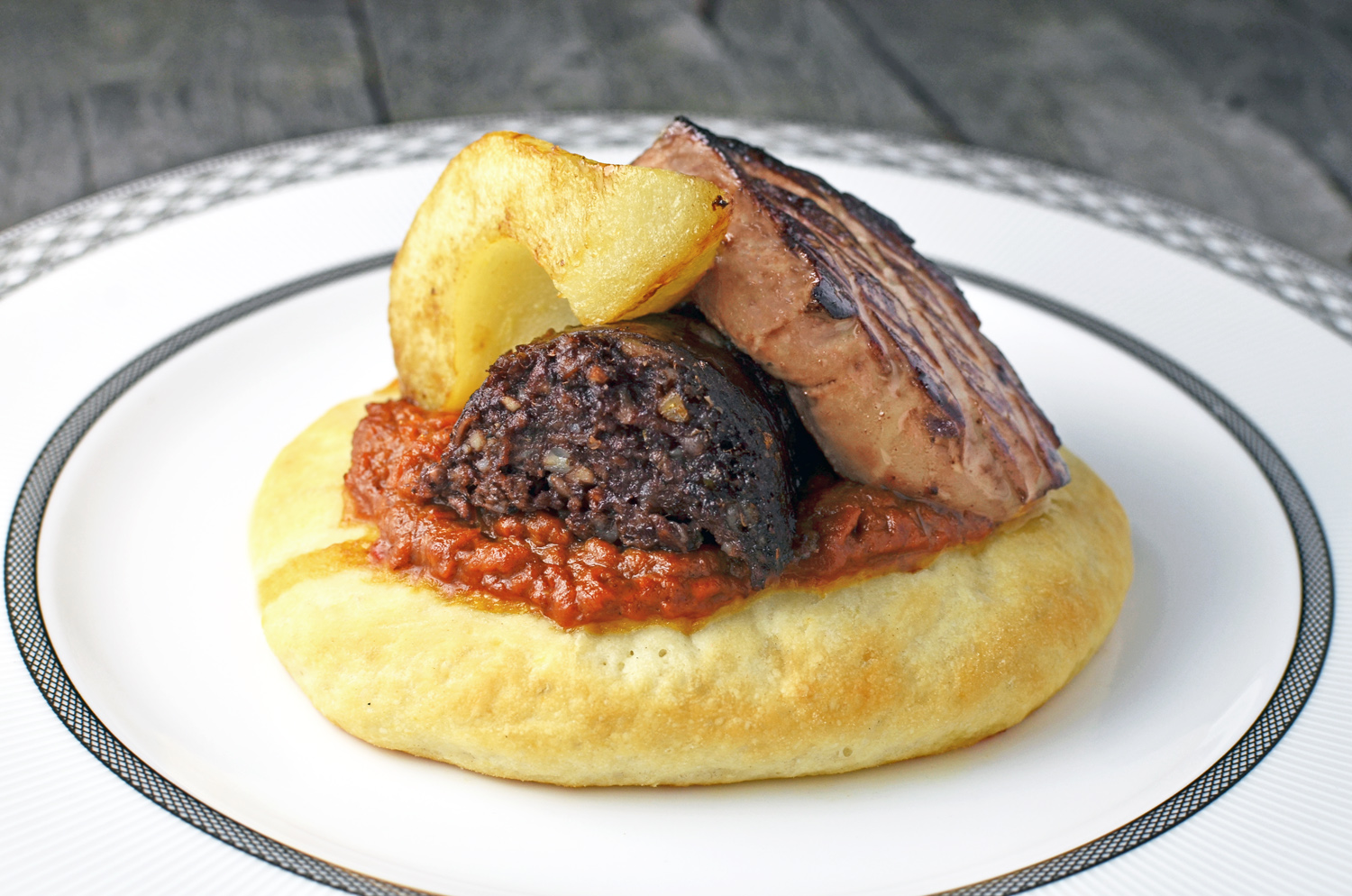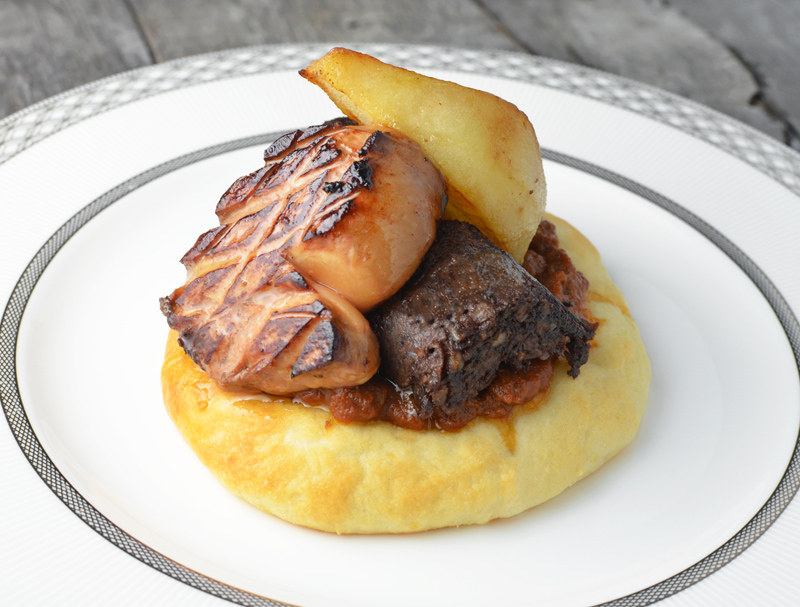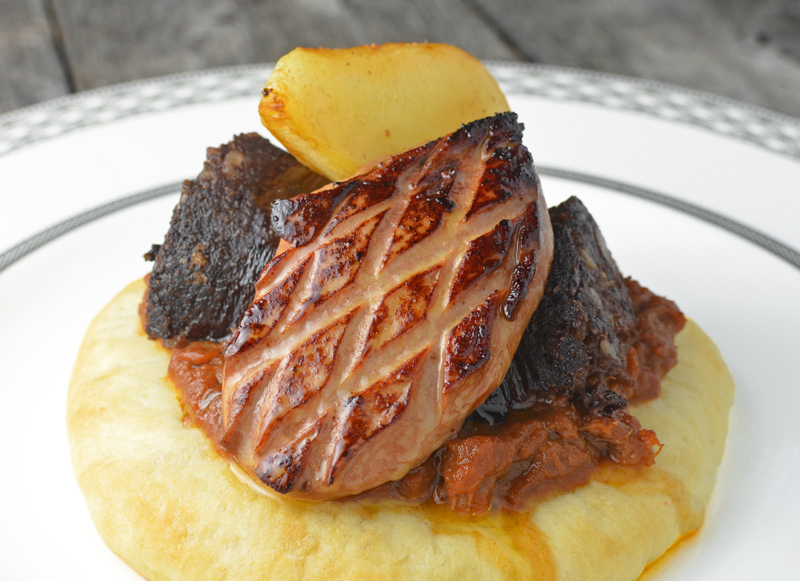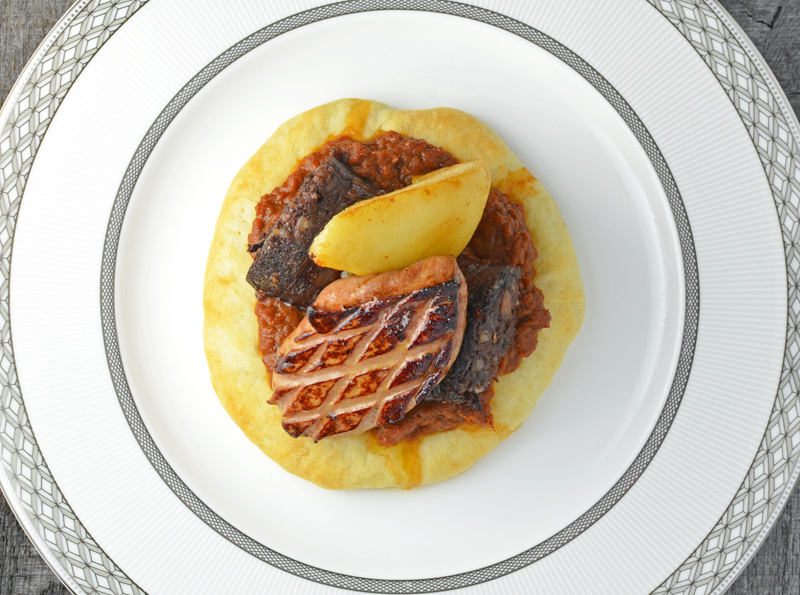Right. It’s the middle of the summer, 30 degrees outside (we’re using the metric system here, remember?), and here I am with my recipe for goulash, blood sausage, and foie gras, like it’s Christmas all over again. As you can imagine, I actually started working on this several months ago, but now you’ll just have to bookmark this page until winter.
The dish is inspired by the decadent cuisine of Au Pied de Cochon in Montreal, where I try to go on pilgrimage once a year. Portions are gargantuan: the charcuterie plate, in the apéritif section, is larger than the typical board for two that New York eateries sell for double the price. Expect to eat at least half a lobe of foie gras per person regardless of what you order. Emptying your plate tends to draw the waiters’ respect. And for a good reason — I dare you to finish the stuffed pig’s foot (stuffed with foie gras, naturally), especially after the charcuterie plate. While they have desserts (of similar proportions, with maple syrup replacing foie gras), you’re highly unlikely to make it that far. There’s no particular merit in serving huge portions, of course — half of America does it. But the food actually tastes very good, and we’re talking about ingredients that are so rich and/or expensive (I once had an entrée with something like an ounce of black truffle), most people consume them in much smaller doses. That’s what makes the place decadent! And for those who want to try Chef Martin Picard’s cooking at home, there’s a cookbook.
So after trying the tarte de boudin et foie gras au sel (a blood sausage and foie gras tart), it occurred to me that I could very easily spin a Hungarian-inspired variation. Why leave all the decadent dishes to the Canadians? Eastern Europe has tons of rich food to compete! Last I checked, blood sausage and foie gras weren’t invented in Quebec, were they? And while we’re at it, why not up the ante a bit, and add some hearty venison goulash?
Still, while my recipe won’t be featured at Weight Watchers any time soon, I made an effort to prevent the dish from being overly rich. I replaced the buttery pie crust with baked lángos. The goulash contains very little fat. Even the buckwheat blood sausage from the East Village Meat Market isn’t too greasy. The pear, a fairly classic pairing with both foie gras and blood sausage, helps to balance the fat. Now, if for some bizarre reason you want to make the tarts richer, you can always pour the rendered fat from the foie gras on top…
I’ve written the recipe to make 12 servings, mostly because it would be hard to accurately scale down the venison goulash and the lángos dough. Still, you could choose to make 12 goulash tartlets, top only a fraction of them with blood sausage, foie gras, and pear, and use your imagination to come up with something else for the remaining ones.
Venison goulash
Yields about 12 servings
480 g cleaned venison leg (or beef chuck), cut into large chunks
30 g canola oil
salt
80 g peeled carrot, medium dice
80 g peeled celery root, medium dice
80 g red pepper, medium dice
160 g peeled onion, medium dice
1 garlic clove, minced
10 g tomato paste
1 g sweet paprika
80 g red wine
480 g water
- In the pot of a pressure cooker, sauté the meat in half of the canola oil over high heat. Season with salt, and cook until brown on all sides, stirring frequently. Reserve.
- In the same pot, sauté the carrot, celery root, red pepper, onion, and garlic over medium heat until lightly colored. Stir in the tomato paste and paprika, and cook until brown.
- Return the meat to the pot, then add the red wine, and simmer for a couple minutes.
- Add the water, seal with the pressure cooker lid, bring to pressure, and cook for 1 hour. Let cool for 30 minutes.
Goulash spread
Yields about 12 servings
venison goulash
30 g butter
4 g sweet paprika
salt
- Pass the goulash through a colander to strain the stock. Reserve the meat and vegetables.
- In a saucepan over high heat, reduce the stock to about 120 g, and remove from the heat.
- Transfer the reduced stock to a blender, and add the butter and paprika. Coarsely chop the stew meat and vegetables, then add to the blender as well. Process until almost smooth, and salt to taste. Let cool and reserve.
Lángos dough
Yields about 12 servings
175 g peeled Yukon gold potato
15 g active dry yeast
15 g sugar
315 g milk, lukewarm
420 g bread flour
2 g salt
55 g butter, melted
- Place the potato in a pot of water, and cook over medium heat until very soft. Mash the potato, and measure 150 g.
- Dilute the yeast and sugar in about 1/3 of the milk, and let rest for 10 minutes.
- Sift the flour into the bowl of an electric mixer fit with the paddle attachment, then mix in the salt. Add the yeast mixture and the rest of the milk, mixing on low speed. Add the butter and the mashed potatoes, mix for another minute, then cover with plastic wrap, and let rest for about 1 hour.
Goulash tartlets
Yields 12 servings
lángos dough
goulash spread
- Divide the dough into 12 parts. Using your hands, flatten each lángos into an 11-12 cm diameter disc. Transfer to baking sheets lined with parchment paper, cover with plastic wrap, and let rest for 30 minutes.
- Place a dish filled with water on the lower rack of your oven, and preheat to 225 C / 450 F.
- Bake the lángos on the middle rack for 5 minutes.
- Take out of the oven, cover each lángos with some of the goulash spread, then return to the oven, and cook for another 4-5 minutes, until the lángos are slightly golden.
- Remove from the oven, transfer to a cooling rack, and reserve.
Assembly
Yields 12 servings
2 Bartlett pears
20 g butter
5 g superfine sugar
720 g foie gras
salt
black pepper, ground
480 g blood sausage
goulash tartlets
- Peel and core the pears, then cut them into 6 wedges each.
- In a pan over low heat, sauté the pears in the butter. Sprinkle with the superfine sugar, and cook until golden brown on all sides.
- Cut the foie gras into 12 pieces, each about 2 cm thick. Season with salt and pepper on both sides, then draw crosshatches on one side using a pairing knife.
- Sauté the foie gras crosshatch-side down, in a hot pan over high heat. Remove some of the rendered fat from the pan regularly, reserving it for the next step or for other recipes. Flip the foie gras, and cook until just brown on both sides. Reserve.
- Peel the blood sausage, and cut into 12 pieces, each about 2.5 cm thick.
- In the same pan as the foie gras, sauté the blood sausage in some of the rendered fat. Cook over medium heat until brown on all sides. Reserve.
- On each each tartlet, arrange one piece of blood sausage cut lengthwise, one piece of foie gras, and one piece of pear.
- Finish the tartlets in a 225 C / 450 F oven for about 2 minutes, and serve immediately. No garnish necessary—you’ll eat vegetables another day.






2 comments
My mouth is watering.
This looks so good It’s killing me.